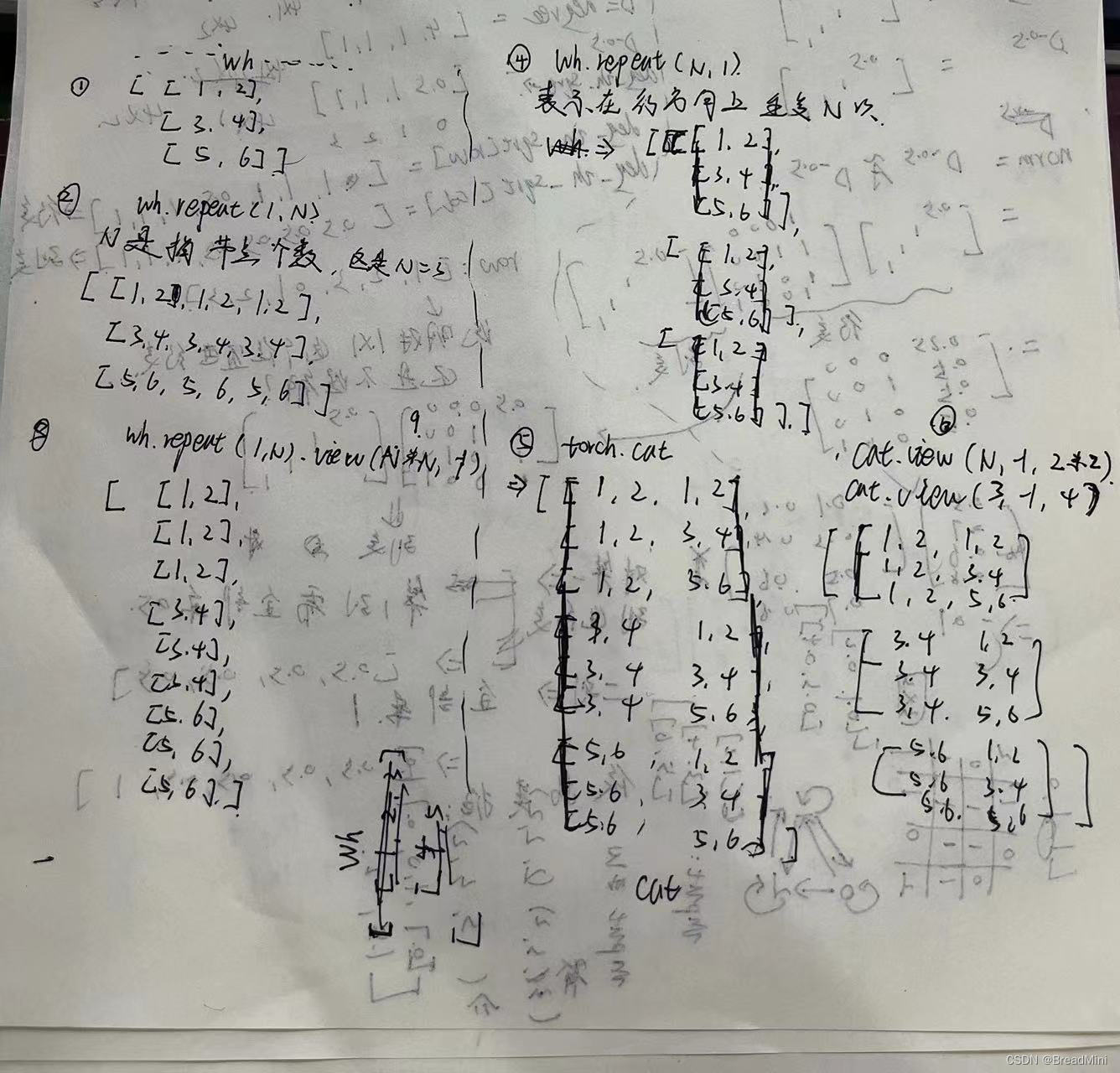图神经网络——GAT
1、为啥要引入GAT呢(个人理解)?
1、传统的图卷积网络(GCN)使用的是预先定义好的邻接矩阵,这也就是说明了每个节点对中心节点的影响都是固定的,无法根据邻接节点不同的特征来确定不同的依赖性。例如,你有100个朋友,其中99个都是你读研之后交到的有钱人,彼此相互联系(从这些复杂交错的联系中多多少少也能够推断出你也是一个有钱人),另一个只是你小时候的发小,只是单独的一个节点,从发小这个节点并不能推断出你是有钱人还是贫穷。 所以引入了GAT,根据节点的特征来计算出邻接权重,故能够更加清晰地标记出不同节点之间的关系。
2、GAT其中的几个重要公式:
1、节点特征的线性变换:

2、计算注意力系数:

3、应用SoftMax:

4、节点特征的聚合:

3、代码实现:
import torch
import torch.nn as nn
import torch.nn.functional as F
class GATLayer(nn.Module):
def __init__(self, in_features, out_features, dropout, alpha, concat=True):
super(GATLayer, self).__init__()
self.in_features = in_features
self.out_features = out_features
self.dropout = dropout
self.alpha = alpha
self.concat = concat
# 定义可训练的参数 W 和 a
self.W = nn.Parameter(torch.empty(size=(in_features, out_features)))
nn.init.xavier_uniform_(self.W.data, gain=1.414)
self.a = nn.Parameter(torch.empty(size=(2 * out_features, 1)))
nn.init.xavier_uniform_(self.a.data, gain=1.414)
# 定义 LeakyReLU 激活函数
self.leakyrelu = nn.LeakyReLU(self.alpha)
def forward(self, h, adj):
# 线性变换
Wh = torch.mm(h, self.W) # h.shape: (N, in_features), Wh.shape: (N, out_features)
N = Wh.size()[0]
# 创建多头注意力机制的输入张量
a_input = torch.cat([Wh.repeat(1, N).view(N * N, -1), Wh.repeat(N, 1)], dim=1).view(N, -1, 2 * self.out_features)
# 计算注意力系数
e = self.leakyrelu(torch.matmul(a_input, self.a).squeeze(2))
# 只保留邻接矩阵中的连接
zero_vec = -9e15 * torch.ones_like(e)
attention = torch.where(adj > 0, e, zero_vec)
# softmax 归一化
attention = F.softmax(attention, dim=1)
# dropout
attention = F.dropout(attention, self.dropout, training=self.training)
# 聚合节点特征
h_prime = torch.matmul(attention, Wh)
if self.concat:
return F.elu(h_prime)
else:
return h_prime
class GAT(nn.Module):
def __init__(self, nfeat, nhid, nclass, dropout, alpha, nheads):
"""Dense version of GAT."""
super(GAT, self).__init__()
self.dropout = dropout
# 定义多头注意力层
self.attentions = [GATLayer(nfeat, nhid, dropout=dropout, alpha=alpha, concat=True) for _ in range(nheads)]
for i, attention in enumerate(self.attentions):
self.add_module('attention_{}'.format(i), attention)
# 输出层
self.out_att = GATLayer(nhid * nheads, nclass, dropout=dropout, alpha=alpha, concat=False)
def forward(self, x, adj):
x = F.dropout(x, self.dropout, training=self.training)
x = torch.cat([att(x, adj) for att in self.attentions], dim=1)
x = F.dropout(x, self.dropout, training=self.training)
x = self.out_att(x, adj)
return F.log_softmax(x, dim=1)
# 创建一个简单的图用于测试
in_features = 5
out_features = 2
nb_nodes = 3
dropout = 0.5
alpha = 0.2
nheads = 3
# 输入特征
input = torch.rand(nb_nodes, in_features)
# 邻接矩阵
adj = torch.tensor([[1, 1, 0], [1, 1, 1], [0, 1, 1]], dtype=torch.float)
# 创建模型并执行前向传播
model = GAT(in_features, out_features, nb_nodes, dropout, alpha, nheads)
output = model(input, adj)
print(output)
让我们来研究这些代码以及公式:
1、
对应代码中的: Wh = torch.mm(h, self.W)
作用:将input(35)矩阵 转变为 (32)的矩阵。
2、
对应代码中的: 创建多头注意力机制的输入张量
a_input = torch.cat([Wh.repeat(1, N).view(N * N, -1), Wh.repeat(N, 1)], dim=1).view(N, -1, 2 * self.out_features)
如何理解这一部分代码呢?
由步骤1 我们可以得到 Wh是(3*2) 的矩阵。
从这些运算步骤可得到结果是右下角那个。
那为啥是要这么计算呢?
理由其实很简单:看图片右下角其中一个
[1,2,1,2,
1,2,3,4,
1,2,5,6]
思考这个矩阵像啥?? [1,2],[3,4],[5,6]分别代表什么?
那不就是代表的是每个节点吗?
[1,2] 到 [1,2] 表示自环
[1,2] 到 [3,4] 表示一个节点到另一个节点。
所以 经过计算之后,能够得到每个节点到其他节点。
然后进行计算注意力系数即可。计算注意力系数 e = self.leakyrelu(torch.matmul(a_input, self.a).squeeze(2)) 这里的a_input 就是上图右下角那个张量。a 是我们自己定义的。 a_input 是(3,3,4) 而a 是(4,1) 计算之后得到 e 是(3,3,1) 再使用squeeze(2) 去除第二维度的1 => e 是(3,3)
3、得到注意力系数attentiuon之后,进行更新h
也称之为:
聚合节点特征
h_prime = torch.matmul(attention, Wh)
attention 是(3*3),而Wh是(3 2),h_prime 是(3 2) 这样就完成了一次邻接节点特征的聚合了。
补充:
对于代码中的:
zero_vec = -9e15 * torch.ones_like(e)
attention = torch.where(adj > 0, e, zero_vec)
解释:因为可能只有 v1 到 v2,而没有v2到v1 ,所有在邻接矩阵中就体现为1 ,则保留原先数据,否则替代为一个很小的数值,减少影响。























 被折叠的 条评论
为什么被折叠?
被折叠的 条评论
为什么被折叠?








